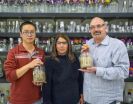(Press-News.org) Winemakers have long known that blending different grape varietals can favorably balance the flavor characteristics of the wine they produce. In the future, makers of advanced biofuels might use a similar strategy, blending different feedstock varieties to balance the energy characteristics of the transportation fuel they produce.
A collaborative study by researchers with the U.S. Department of Energy (DOE)'s Joint BioEnergy Institute (JBEI), a bioenergy research center led by Berkeley Lab, and the Idaho National Laboratory (INL) has shown that an ionic liquid proven to be effective for pre-treating individual biofuel feedstocks is also effective at pre-treating multiple different feedstocks that have been mixed and densified into a blend.
"Our results show that an ionic liquid pre-treatment can efficiently handle mixed feedstocks that have been milled and densified into pellets, and can generate high yields of fermentable sugars regardless of upstream processing," says Blake Simmons, a chemical engineer who heads JBEI's Deconstruction Division. "This indicates that blending and densifying a wide range of feedstocks has significant potential for helping to make biofuels a cost-competitive transportation fuel technology."
Simmons and his JBEI colleague Seema Singh, director of JBEI's Biomass Pretreatment group, led the JBEI/INL study in which four biomass feedstocks, representing the general classes of plants well-suited to serving as fuel crops, were mixed and milled into either flour or pellets then pre-treated with 1-ethyl-3-methylimidazolium acetate ([C2mim][OAc]), the ionic liquid used at JBEI as a benchmark for biomass processing. The objective was to determine the impact of mixing and densification on the efficiency at which the complex polysaccharides in cellulosic biomass could be converted into fermentable sugars for fuel production.
"Lignocellulosic biorefineries must be able to efficiently process available regional feedstocks at cost-competitive prices year round, but feedstocks markedly vary from region-to-region," Singh says. "Also, individual feedstocks within a given region are also quite variable, depending on weather conditions, handling, storage and crop variety. Blending and densifying different feedstocks to create a single uniform feedstock has been proposed as a solution, but not much scientific attention has been paid to the efficiency of converting mixtures of feedstocks into fermentable sugars and fuels."
Given that global temperatures are now setting record highs and that the burning of fossil fuels is releasing an additional 9 billion metric tons of excess atmosphere-warming carbon each year, both the planet and the American economy stand to benefit from a large-scale domestic advanced biofuels industry. Produced from the microbial fermentation of sugars in lignocellulosic biomass, advanced biofuels are clean, green and renewable, and could displace gasoline, diesel and jet fuel on a gallon-for-gallon basis and be directly dropped into today's engines and infrastructures.
The sugars in lignocellulosic biomass, however, are complex polysaccharides that are deeply embedded within a very recalcitrant material called lignin. To break apart the complex lignocellulose and help hydrolyze the released polysaccharides into sugars that can be fermented by microbes, researchers at JBEI and elsewhere have been studying biomass pretreatments with ionic liquids – environmentally benign organic salts often used as green chemistry substitutes for volatile organic solvents.
Researchers at INL have been investigating ways to increase the energy densities of biomass feedstocks and make delivery to refineries much more economical. Milling feedstocks into flour or pellets is an effective process for large-scale energy densification, but before this latest study it was unknown as to how densification of single or mixed feedstocks would impact ionic liquid pretreatment and sugar yield.
The JBEI/INL collaboration mixed switchgrass, lodgepole pine, corn stover and eucalyptus in flour and pellets and within 24 hours of saccharification were able to obtain sugar yields of up to 90-percent for both forms. Pellets, because of their higher energy density, would be the preferred form.
"Our work is the first demonstration that ionic liquid pretreatments can effectively handle mixed and densified feedstocks," Simmons says. "We're continuing the collaboration to next identify the most economical pelletized feedstock mixtures based on targeted regions of the United States. We'' then determine how efficiently our process can convert these mixtures into fermentable sugars."
INFORMATION:
The collaboration has published their results in the journal Biofuels in a paper titled "Impact of mixed feedstocks and feedstock densification on ionic liquid pretreatment efficiency." Co-authors, in addition to Simmons and Singh, were JBEI's Jian Shi and Vitalie Stavila, and INL's Vicki Thompson and Neal Yancey.
JBEI is one of three Bioenergy Research Centers established by the DOE's Office of Science in 2007. It is a scientific partnership led by Berkeley Lab and includes the Sandia National Laboratories, the University of California campuses of Berkeley and Davis, the Carnegie Institution for Science, and the Lawrence Livermore National Laboratory. DOE's Bioenergy Research Centers support multidisciplinary, multi-institutional research teams pursuing the fundamental scientific breakthroughs needed to make production of cellulosic biofuels, or biofuels from nonfood plant fiber, cost-effective on a national scale.
Lawrence Berkeley National Laboratory addresses the world's most urgent scientific challenges by advancing sustainable energy, protecting human health, creating new materials, and revealing the origin and fate of the universe. Founded in 1931, Berkeley Lab's scientific expertise has been recognized with 13 Nobel prizes. The University of California manages Berkeley Lab for the U.S. Department of Energy's Office of Science. For more, visit www.lbl.gov.
DOE's Office of Science is the single largest supporter of basic research in the physical sciences in the Unites States, and is working to address some of the most pressing challenges of our time. For more information, please visit the Office of Science website at science.energy.gov.
Biofuels blend right in
Researchers show ionic liquids effective for pre-treating mixed blends of biofuel feedstocks
2013-01-31
ELSE PRESS RELEASES FROM THIS DATE:
In beef production, cow-calf phase contributes most greenhouse gases
2013-01-31
Jan. 30 2013 - Scientists have long known that cattle produce carbon dioxide and methane throughout their lives, but a new study pinpoints the cow-calf stage as a major contributor of greenhouse gases during beef production.
In a new paper for the Journal of Animal Science, scientists estimate greenhouse gas emissions from beef cattle during different stages of life. They show that, depending on which production system farmers used, beef production has a carbon footprint ranging from 10.7 to 22.6 kg of carbon dioxide equivalent per kg of hot carcass weight.
According ...
Confirmed: How plant communities endure stress
2013-01-31
PROVIDENCE, R.I. [Brown University] — Ecology is rife with predation, competition, and other dramatic "negative interactions," but those alone do not determine the course life on Earth. Organisms sometimes benefit each other, too, and according to the Stress Gradient Hypothesis, their "positive interactions" become measurably more influential when ecosystems become threatened by conditions such as drought. Ecologists have argued about the hypothesis ever since Brown University ecologist Mark Bertness co-proposed it in 1994; Bertness says a large new global meta-analysis ...
Peer pressure trumps 'thin' ideals in the media
2013-01-31
Peers exert a greater influence on teenage girls' dissatisfaction with their bodies than do thin ideals in television or social media use, according to new research¹ by Dr. Christopher J. Ferguson and colleagues from Texas A&M International University in the U.S. Their study is published online in Springer's Journal of Youth and Adolescence.
The influence of the media on body image, life satisfaction, and symptoms of eating disorders in teenage girls is a hot debate. Some experts believe that media influences on body dissatisfaction may extend to symptoms of eating disorders. ...
Lake Mead aquatic-science research documents substantial improvements in ecosystem
2013-01-31
LAS VEGAS, Nev. — Lake Mead National Recreation Area's water quality is good, the sport fish populations are sufficient, and the lakes provide important habitat for an increasing number of birds. This positive trend is documented in a new report published today that leads to a better understanding of the natural resources of Lake Mead and Lake Mohave, and the issues that may affect natural resource management of Lake Mead NRA.
"While the Lake Mead ecosystem is generally healthy and robust, the minor problems documented in the report are all being addressed by the appropriate ...
Discovery of sexual mating in Candida albicans could provide insights into infections
2013-01-31
Like many fungi and one-celled organisms, Candida albicans, a normally harmless microbe that can turn deadly, has long been thought to reproduce without sexual mating. But a new study by Professor Judith Berman and colleagues at the University of Minnesota and Tel Aviv University shows that C. albicans is capable of sexual reproduction.
The finding, published online by Nature January 30, represents an important breakthrough in understanding how this pathogen has been shaped by evolution, which could suggest strategies for preventing and treating the often serious infections ...
Are gender and ethnicity risk factors for metabolic syndrome in children?
2013-01-31
New Rochelle, NY, January 30, 2013—Metabolic syndrome is more likely to affect children who are obese than overweight or non-overweight and who have other characteristics associated with the disorder, such as high blood pressure or insulin resistance. A new comprehensive and systematic review of the medical literature on metabolic syndrome in children that probed deeper to evaluate the risk associated with gender, ethnicity, and geography was published in Metabolic Syndrome and Related Disorders, a peer-reviewed journal from Mary Ann Liebert, Inc., publishers. The article ...
Silibinin, found in milk thistle, protects against UV-induced skin cancer
2013-01-31
A pair of University of Colorado Cancer Center studies published this month show that the milk thistle extract, silibinin, kills skin cells mutated by UVA radiation and protects against damage by UVB radiation – thus protecting against UV-induced skin cancer and photo-aging.
"When you have a cell affected by UV radiation, you either want to repair it or kill it so that it cannot go on to cause cancer. We show that silibinin does both," says Rajesh Agarwal, PhD, co-program leader of Cancer Prevention and Control at the CU Cancer Center and professor at the Skaggs School ...
Prostate cancer study tracks long-term urinary, sexual and bowel function side effects
2013-01-31
A new study comparing outcomes among prostate cancer patients treated with surgery versus radiotherapy found differences in urinary, bowel and sexual function after short-term follow-up, but those differences were no longer significant 15 years after initial treatment.
The study, led by first author Matthew Resnick, M.D., instructor in Urologic Surgery, Vanderbilt University Medical Center, was published in the Jan. 31 issue of the New England Journal of Medicine.
From Oct. 1, 1994, through Oct. 31, 1995, investigators enrolled men who had been diagnosed with localized ...
Checking out open access
2013-01-31
This press release is available in French.
Montreal, January 20, 2013 – From Wikipedia to shareware, the Internet has made information and software more widely available than ever. At the heart of this explosion is the simple idea that information should be open and free for anyone. Yet with publishers charging exorbitant fees for subscriptions to academic journals, university libraries are struggling to keep up.
Writing in the Journal of Academic Librarianship, Concordia collections librarian Geoffrey Little says that a key way to meet that challenge is through ...
Sorting out stroking sensations
2013-01-31
PASADENA, Calif.—The skin is a human being's largest sensory organ, helping to distinguish between a pleasant contact, like a caress, and a negative sensation, like a pinch or a burn. Previous studies have shown that these sensations are carried to the brain by different types of sensory neurons that have nerve endings in the skin. Only a few of those neuron types have been identified, however, and most of those detect painful stimuli. Now biologists at the California Institute of Technology (Caltech) have identified in mice a specific class of skin sensory neurons that ...
LAST 30 PRESS RELEASES:
Sleeping in on weekends may help boost teens’ mental health
Study: Teens use cellphones for an hour a day at school
After more than two years of war, Palestinian children are hungry, denied education and “like the living dead”
The untold story of life with Prader-Willi syndrome - according to the siblings who live it
How the parasite that ‘gave up sex’ found more hosts – and why its victory won’t last
When is it time to jump? The boiling frog problem of AI use in physics education
Twitter data reveals partisan divide in understanding why pollen season's getting worse
AI is quick but risky for updating old software
Revolutionizing biosecurity: new multi-omics framework to transform invasive species management
From ancient herb to modern medicine: new review unveils the multi-targeted healing potential of Borago officinalis
Building a global scientific community: Biological Diversity Journal announces dual recruitment of Editorial Board and Youth Editorial Board members
Microbes that break down antibiotics help protect ecosystems under drug pollution
Smart biochar that remembers pollutants offers a new way to clean water and recycle biomass
Rice genes matter more than domestication in shaping plant microbiomes
Ticking time bomb: Some farmers report as many as 70 tick encounters over a 6-month period
Turning garden and crop waste into plastics
Scientists discover ‘platypus galaxies’ in the early universe
Seeing thyroid cancer in a new light: when AI meets label-free imaging in the operating room
Neutrophil-to-lymphocyte ratio may aid risk stratification in depressive disorder
2026 Seismological Society of America Annual Meeting
AI-powered ECG analysis offers promising path for early detection of chronic obstructive pulmonary disease, says Mount Sinai researchers
GIMM uncovers flaws in lab-grown heart cells and paves the way for improved treatments
Cracking the evolutionary code of sleep
Medications could help the aging brain cope with surgery, memory impairment
Back pain linked to worse sleep years later in men over 65, according to study
CDC urges ‘shared decision-making’ on some childhood vaccines; many unclear about what that means
New research finds that an ‘equal treatment’ approach to economic opportunity advertising can backfire
Researchers create shape-shifting, self-navigating microparticles
Science army mobilizes to map US soil microbiome
Researchers develop new tools to turn grain crops into biosensors
[Press-News.org] Biofuels blend right inResearchers show ionic liquids effective for pre-treating mixed blends of biofuel feedstocks




